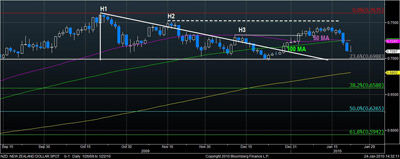NZD/USD:
The Kiwi has had a phenomenal ride against the Greenback for nearly a year. It is the single largest percent gainer amongst the G-7 over that period of time. The Dollar has gained some strength as of late and commodity currencies have been selling off as China acts to curbs excess liquidity in the market. Thus, since January 14, 2010 the NZD has been the biggest loser against the USD, giving up 2.81%
To close 2009 the NZD broke from a triangle formation where .70 held firm support. In the graph below you can see, the New Zealand Dollar was heading towards the corner of the triangle when it popped, breaking through not only the hypotenuse, but also taking out the 100 day MA and eventually the 50 day MA.

We have also identified a nice step pattern which has its high occur near the 15th of every month. On the graph above we labeled H1, H2, and H3 for the consecutive falling highs, which make up the lower high step pattern. Although H3 was breached, we allow for a single breach so long as it only takes out one previous level and it subsequently forms a new low. If H2 was breached we would have favored a long NZD position.
The next point of entry will occur with a close below .6988. This is a significant level for many reasons. Firstly, a close below .70, takes out the prior support level. Secondly, using a Fibonacci Retrace from the low set in early March at .4895 to the high struck in mid October at .7635, generates a 23.6% Retrace level right at .70. Third, a close at this level would continue out step pattern, by creating a lower low, and thereby confirming our Short NZD bias.
If the short entry signal triggers, we would expect the Kiwi to fall until the 200 day MA, currently at .68. If the 200 day MA is taken out, our next target is the Fibonacci 38.2% level at .6588. Conversely, if the NZD does not break support at .70, as many currencies are currently trading a volatile range against the Greenback, then we expect the Kiwi will retest its most recent high near .7440 by mid February.